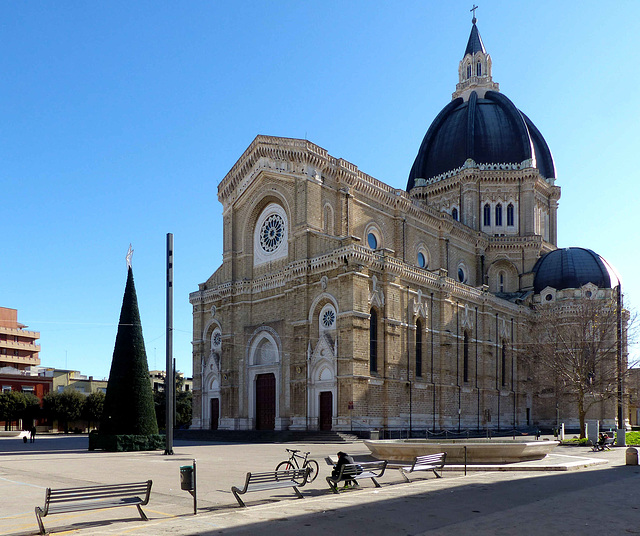Puglia
Trani - San Nicola Pellegrino
Trani - San Nicola Pellegrino
Trani - Castello Svevo
Trani - Bar Boschetto
Trani - Santa Maria di Colonna
Trani - San Giacomo
Trani - Chiesa di Ognissanti
Ruvo di Puglia - Concattedrale di Santa Maria Assu…
Ruvo di Puglia - Concattedrale di Santa Maria Assu…
Bitonto - Duomo di Bitonto
Bitonto - Duomo di Bitonto
Bitonto - Duomo di Bitonto
Bitonto - Duomo di Bitonto
Bitetto - San Michele Arcangelo
Bitetto - San Michele Arcangelo
Bitetto - San Michele Arcangelo
Bitetto - San Michele Arcangelo
Bitetto - San Michele Arcangelo
Bitetto - San Michele Arcangelo
Bari - Piazza del Ferrarese
Bari - Cattedrale di San Sabino
Bari - Cattedrale di San Sabino
Benevento - Sant'Ilario in Port'Aurea
Benevento - Museo Arcos
Benevento - Museo Arcos
Benevento - Teatro romano
Benevento - Teatro romano
Benevento - Museo del Sannio
Benevento - Museo del Sannio
Benevento - Museo del Sannio
Benevento - Museo del Sannio
Benevento - Santa Sofia
Benevento - Santa Sofia
Benevento - Santa Sofia
Benevento - Santa Sofia
Benevento - Santa Sofia
Benevento - Santa Sofia
Benevento - Santa Sofia
Benevento - Santa Sofia
Benevento - Santa Sofia
Benevento - Santa Sofia
Benevento - Santa Sofia
Benevento - Santa Sofia
Benevento - Santa Sofia
Location
Lat, Lng:
You can copy the above to your favourite mapping app.
Address: unknown
You can copy the above to your favourite mapping app.
Address: unknown
See also...
Keywords
Authorizations, license
-
Visible by: Everyone -
All rights reserved
-
74 visits
Cerignola - Cattedrale di San Pietro Apostolo


Cerinogla was a municipium at the time of the Roman Empire. Re-founded by the Normans, in the Middle Ages it became part of the Kingdom of Naples and from 1418 it was the feudal property of the Caracciolo family for several centuries.
In 1503 the city was the scene of the struggle between the French and the Spanish for the possession of the Kingdom of Naples. The "Battle of Cerignola" saw the victory of the Spaniards, so that the Kingdom of Naples became Spanish.
Since the previous cathedral was no longer sufficient for the population of Cerignola at the beginning of the 19th century, a new church was to be built. After the rich fellow citizen Paolo Tonti had bequeathed his fortune to the city in 1855 for the construction of the new cathedral (that's why many call it "Duomo Tonti"), the construction of the neo-Gothic cathedral was finally started in 1873. Work progressed slowly and in 1934 the inauguration was celebrated.
In 1503 the city was the scene of the struggle between the French and the Spanish for the possession of the Kingdom of Naples. The "Battle of Cerignola" saw the victory of the Spaniards, so that the Kingdom of Naples became Spanish.
Since the previous cathedral was no longer sufficient for the population of Cerignola at the beginning of the 19th century, a new church was to be built. After the rich fellow citizen Paolo Tonti had bequeathed his fortune to the city in 1855 for the construction of the new cathedral (that's why many call it "Duomo Tonti"), the construction of the neo-Gothic cathedral was finally started in 1873. Work progressed slowly and in 1934 the inauguration was celebrated.
Vicente López García, Paolo Tanino, Alexander Prolygin, Fred Fouarge have particularly liked this photo
- Keyboard shortcuts:
Jump to top
RSS feed- Latest comments - Subscribe to the comment feeds of this photo
- ipernity © 2007-2025
- Help & Contact
|
Club news
|
About ipernity
|
History |
ipernity Club & Prices |
Guide of good conduct
Donate | Group guidelines | Privacy policy | Terms of use | Statutes | In memoria -
Facebook
Twitter

Sign-in to write a comment.